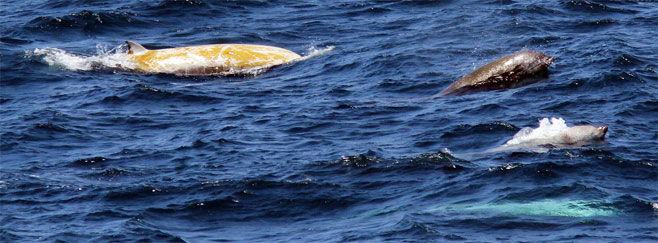|
Ziphius cavirostris (Cuvier's
beaked whale)
goose-beaked whale [English]; Cuvier se snoetwalvis
[Afrikaans]
Life
>
Eukaryotes >
Opisthokonta >
Metazoa (animals) > Bilateria > Deuterostomia >
Chordata > Craniata > Vertebrata (vertebrates) >
Gnathostomata (jawed vertebrates) > Teleostomi (teleost
fish) > Osteichthyes (bony fish) > Class:
Sarcopterygii (lobe-finned fish) > Stegocephalia
(terrestrial vertebrates) > Reptiliomorpha > Amniota >
Synapsida (mammal-like reptiles) > Therapsida > Theriodontia
> Cynodontia > Mammalia (mammals)
> Placentalia (placental mammals) >
Laurasiatheria > Ferungulata > Cetartiodactyla (even-toed ungulates and
cetaceans) > Whippomorpha > Cetacea (whales, dolphins and
porpoises) > Family: Ziphiidae (beaked whales)
> Subfamily: Ziphiinae
These beaked whales are known for their extreme
colour variation and patterning between individuals. Their
colouration ranges from sienna to a dark browny blue, with older
males known to have almost white heads. Adult males bears scars of a
characteristic ‘double track’, that are made by other Cuvier’s
whales. These whales are of medium length, around 6,5 metres, and
weigh on average 3 000 kilograms. They feed mainly on squid.
 |
|
Cuvier's beaked whales off the coast of
California. [photo
Knut Hansen ©] |
Text by Derek Ohland
|
